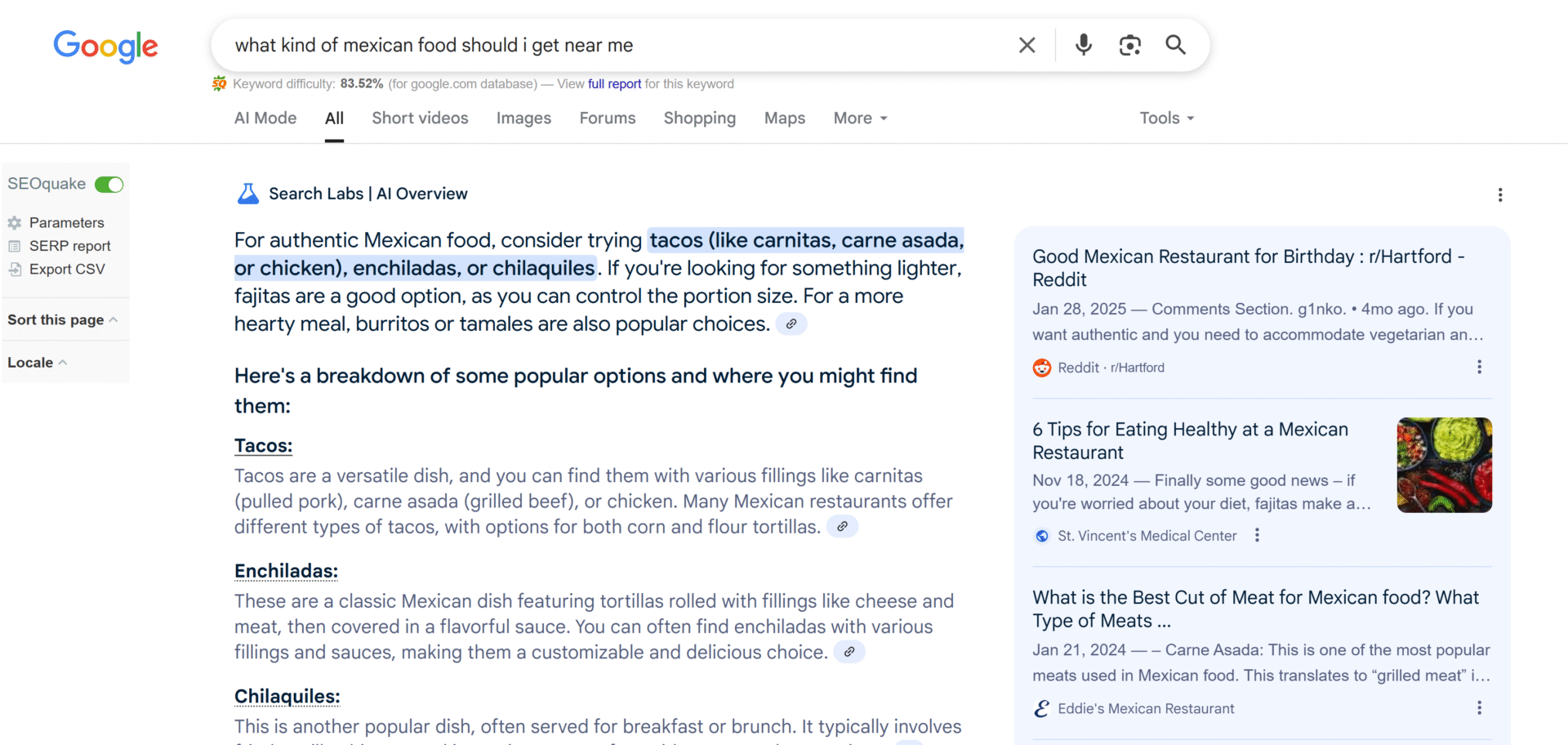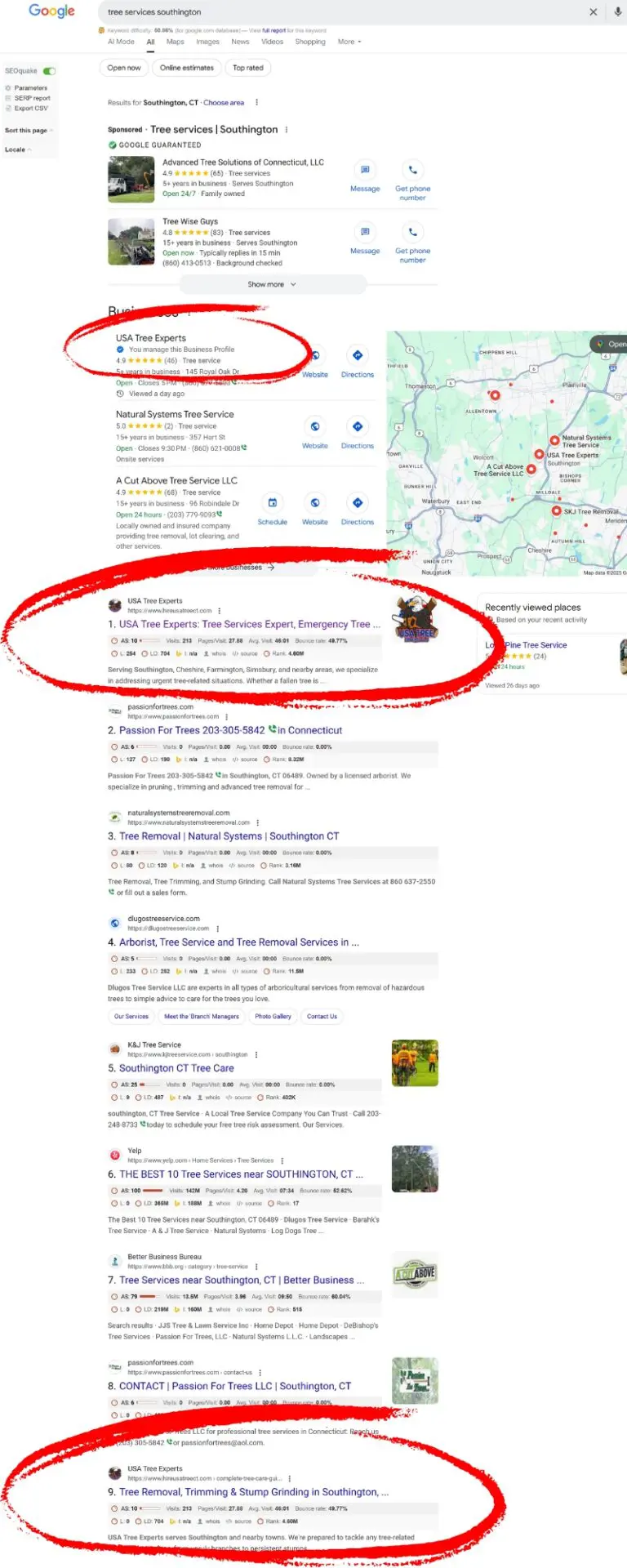Are you showing up in Google AI Overview?
So how AI is changing the search if you own a home service business, you’ve probably noticed how AI is changing search results — fast. It’s not just another algorithm tweak. It’s a transformation in how homeowners find local companies like yours. Maybe you’ve adjusted your keywords or updated your website before. But this shift is bigger — and it directly affects how your business gets discovered.
A Quick Look Back: How SEO Worked in the Past
In the early days of SEO, getting found on Google was all about technical tricks. You’d pick a short, popular keyword — like “plumber CT” —
and sprinkle it throughout your website. The more often it appeared, the better your chances of ranking.
Then came backlinks. Search engines began measuring how many other websites linked to yours. If 100 sites pointed to your page, that was a
signal of trust — even if those links came from irrelevant directories or low-quality blogs. So SEO became a game of volume: more keywords,
more links, more pages.
Later, things matured. Google began looking at user behavior, content quality, and page speed. SEO agencies had to shift from spammy tactics
to more strategic approaches. Still, the playbook stayed relatively consistent: optimize for keywords, build links, tweak metadata, and submit sitemaps.
That playbook is now being rewritten. Welcome to the age of AI-powered search.
Google’s new “AI Mode” is shifting how results are delivered — not just which websites rank highest, but which ones are used as sources in
AI-generated answers. And that distinction is massive.
At Southington Digital Solutions, we’ve been watching this unfold for over two years.
Quietly, methodically, we’ve been getting our clients ready for a world where search is about knowledge, clarity, and authority —
not just keyword counts and backlinks.
This post will break down exactly what’s changing, how it will affect your business, and why this shift actually favors the local contractor,
the small remodeler, and the business owner who knows their craft — if the right strategy is in place.
AI Mode and How It’s Changing Search for Local Businesses
Google AI Mode started as an experiment, tucked into a separate tab. But in 2024 and into 2025, it’s creeping into the main results page.
When homeowners ask Google a question like “how much does a detached garage cost in CT?” they may now see an AI-generated summary
pulled from a handful of trusted websites.
If your site is one of those sources — great. You just earned visibility without relying on old-school rankings.
If it’s not — your business may never be seen, even if you were traditionally ranked on page one.
That’s because AI Mode doesn’t work like traditional search. It’s not just scanning for keywords — it’s reading your content like a human,
looking for clarity, expertise, and alignment with the user’s intent.
If your website lacks structured data (schema), detailed service information, or doesn’t clearly answer common customer questions,
Google’s AI might skip it entirely — not out of malice, but simply because it couldn’t find what it needed in a digestible, structured way.
This is why content structure, schema markup, and real-world clarity matter more than ever. Visibility is no longer guaranteed by rankings —
it’s earned by relevance and readability.
Long-Tail Queries: The New Normal for AI-Driven Search
Instead of typing in short phrases like “kitchen remodeler”, more homeowners are now searching in full, conversational questions:
- “How long does a kitchen remodel take in Connecticut?”
- “What’s the best material for a cold-weather deck?”
- “Do I need permits to build a detached garage in Southington?”
These are called long-tail queries — and they’re becoming the foundation of modern search. The more specific the question,
the more likely AI Mode will display a summarized answer right on the results page.
Historically, long-tail keywords were used in SEO to capture “low competition” traffic. But now, they play a central role in
how AI evaluates and pulls content. It’s not just about traffic — it’s about positioning your business as the best possible answer.
That means your content needs to go beyond just listing services. It needs to explain things the way you would in person — clearly,
without fluff, and in a way that’s genuinely helpful to the reader.
At Southington Digital Solutions, when we build SEO content, we reverse-engineer real questions homeowners ask and structure content
to address them head-on. This not only improves your chances of being cited in AI-generated responses, but also makes your website
more valuable to actual customers.
The shift to long-tail is not a trend — it’s the new standard. If your site speaks the language of your customers, Google’s AI is more likely to listen.
Why Backlinks Still Count — But May Matter Less in AI Search
Backlinks — links from other websites pointing to your site — have long been a cornerstone of traditional SEO. Google historically used them
as a vote of confidence: if other websites link to your content, it must be trustworthy or valuable. In the early 2010s, backlink volume alone
could boost rankings, even if the linked content wasn’t particularly helpful or current.
And yes — for now, backlinks still work. They help validate your website’s presence, provide indirect traffic, and can boost your visibility in traditional organic results. That’s why we still monitor them, build them strategically, and include link outreach as a **supporting** component in our SEO strategy — especially in campaigns where authority-building is essential.
However, in a world increasingly dominated by AI-generated answers and semantic search, the rules are changing. AI systems are shifting focus from link-based authority to **content-based clarity**. Instead of asking “Who links to this site?” AI is asking “Does this site clearly answer the question the user asked?”
For many home service professionals, this is a massive opportunity. You don’t need to land features in high-profile publications or run a PR campaign to build visibility. What matters now is whether your website reflects your actual expertise — whether it explains your services clearly, addresses real customer questions, and provides enough structured data for search engines to understand your value.
That’s why our focus has shifted toward **content quality, long-tail search strategy, and custom schema markup**. We treat backlinks as amplifiers — helpful, but no longer the foundation. Instead, we focus on creating authority through **in-depth service pages, long-form blog content, and structured metadata** that help AI and Google interpret your site correctly.
This shift also aligns with how we approach online visibility strategies beyond search, such as social media integration. While backlinks once helped you rank, now it’s about being cited, quoted, and understood across all digital platforms — and that means showing up consistently and authoritatively wherever your customers look.
So while backlinks still matter today, we believe their role will diminish further in the next few years. AI isn’t concerned with who linked to you in 2019. It’s looking at your content right now — and asking whether it helps, teaches, and solves.
That’s why we prioritize clarity, not just traffic — and why your next SEO win may come from what’s already in your head, not from who’s linking to your site.
Creative SEO: Turning Knowledge Into Visibility
Gone are the days when you could rank with a generic 500-word blog post stuffed with phrases like “HVAC repair near me.” That kind of content
doesn’t just fail to impress Google — it gets ignored by AI entirely.
Creative SEO is our way of responding to how AI is changing search for home service businesses — by turning real expertise into trusted content.
Today’s SEO is about demonstrating authority. You don’t prove expertise by repeating keywords. You prove it by walking the reader through
your process, explaining options, answering questions, and showing that you understand what homeowners care about.
We call this Creative SEO — and it’s a core part of our strategy.
It starts with research. We don’t guess what people are asking — we use real search data, AI tools, and industry questions to uncover
what homeowners are typing into Google. Tools like AnswerThePublic and Google’s own
“People Also Ask” sections show us exactly where to focus.
Then we build content around those questions — long-form pages that explain things clearly, without fluff or filler. We use structured headings, supporting visuals,
and smart SEO tags (like title tags, meta descriptions, and schema) to help Google and AI understand what each page is about.
Whether we’re describing the process of building a garage, comparing insulation types, or explaining permit timelines — we turn your knowledge into assets.
That’s how you get discovered.
This kind of content doesn’t just help with search. It builds trust. It turns browsers into leads. And it gives AI the context it needs
to quote you in answers and overviews.
Custom Schema: Helping AI Understand What You Do
Schema markup is behind-the-scenes code that gives search engines more context about your website content.
Think of it like closed captions — it doesn’t change what’s on the screen, but it helps machines understand what’s being said.
You’ve probably seen schema in action: star ratings, FAQ dropdowns, service categories, and business details that show up
right in the search results. That’s not random — it’s structured data telling Google exactly what to display.
In traditional SEO, schema was optional. But for AI Mode? It’s a critical component. AI needs clear, structured signals
to determine what your business offers, where you serve, and how your content relates to a given query.
That’s why we go beyond basic schema plugins. We build custom schema structures tailored to your specific services,
towns, and unique offerings. This allows AI tools to recognize and surface your content more accurately.
For example, we create schema that defines:
- Your service areas by town
- Each individual service you offer
- Customer reviews attached to specific pages
- Content relationships (e.g., blog posts tied to service pages)
This structure not only improves your visibility in traditional Google results — it helps your site become a trusted data source
for AI-powered summaries and Overviews.
In short: schema is your website’s translator. And the more fluently you speak Google’s language, the better your visibility.
Our Clients Were Prepared — Because We Saw This Coming
We didn’t start optimizing for AI search last week. This shift has been on our radar for years.
We saw the signs: longer search queries, more conversational Google results, and a clear drop in the effectiveness of backlink-only strategies.
So we began adapting early — restructuring how we write, design, and build every client site.
If you’re already a client of ours, chances are your site is already AI-ready:
- Your service pages are optimized for long-tail, natural-language searches
- You have custom schema tailored to your business and towns
- Your site speaks clearly to both human readers and AI systems
Some of our clients are already showing up in Google’s AI Overviews — not because of luck, but because of intentional strategy.
Every bit of structured content, every long-form blog post, and every schema tag was designed with this shift in mind.
If you’re not yet working with us, there’s still time to get ahead. Start with a free AI SEO Readiness Report here:
https://southingtondigital.com/seo/
Final Thought: Authority Now Beats Everything
You don’t need to be a celebrity business or have thousands of backlinks to win in today’s AI-driven search.
What you need is clarity. You need to communicate what you do, how you do it, and why it matters — in plain, helpful language that
both your customers and Google’s AI can understand.
The businesses that show real-world knowledge — not in theory, but through well-written, honest, and organized content — will be
the ones that get surfaced in AI results and traditional search alike.
If you’ve partnered with us already, you’re likely ahead of the curve. And if you haven’t yet, this is your chance to close that gap.
AI isn’t just changing how people search — it’s deciding who gets seen.
The good news? It’s not too late. You don’t need to game the system — you just need to align with it.
If you’re unsure how AI is changing search for home service businesses like yours, our free visibility report can help pinpoint what to do next.
We’re here to help make sure your business is one that AI promotes — not skips.
Bonus: A Simple Checklist to Future-Proof Your Website for AI Search
Want to know where your website stands right now? Use this checklist to self-audit your AI SEO readiness.
- ✅ Do your service pages clearly answer specific customer questions?
- ✅ Are your blog posts written in a conversational, easy-to-read tone?
- ✅ Have you implemented schema markup for your services, locations, and reviews?
- ✅ Are you targeting long-tail, natural-language queries in your content?
- ✅ Does your website reflect your actual process, expertise, and experience?
If you answered “no” or “I’m not sure” to any of these — you’re not alone. And that’s exactly why we created a free AI SEO Readiness Report.
👉 Get your free visibility report here — it’s designed to help local service businesses like yours get found by both humans and AI.
The future of search is already here. Make sure your business isn’t left out of it.



